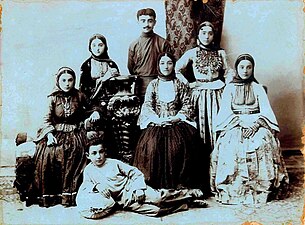Men's wear
Outerwear
National outerwear for men consists of a ust koyney (shirt) or Chepken, Arkhalig, Gaba, Chukha and Kurk.
- Arkhalig – a long, tight, waist-jacket made of fabrics including silk, satin, cloth, cashmere and velvet, depending on the social status of its owner.
- Gaba – male humeral outerwear, which is made from tirma, an expensive shawl fabric with a woven pattern of wool or silk.
- Chukha – male humeral outerwear with layers and gathers that is detachable at the waist. It is made of cloth, tirma, and homespun textiles.
- Kurk – a collared lamb-fur coat without fastener and decorated with embroidery.
A Russian ethnographer[who?] writes about Azerbaijani male costume:[2][further explanation needed]
Underwear consists of straight and short shirts of coarse calico, white and mostly dark blue colours with underpants of this very material, which are fastened with tapes on the waist; in winter they are worn over woolen large pants, which are also fastened with tapes. Over a shirt is worn arkhalig made of cotton. Arkhalig is such as a Russian man's long tight-fitting coat with a short waist and short skirt with gathers on the belt; it is always fastened tightly or in the midst or aside of the chest. Chukha is worn over arkhalig with a short waist and with a skirt with a length of below knees, but the head is covered with a small conic shaped hat made of lamb fur, throughout the year. Short woollen socks are worn to feet.
Headdresses
The Papaq was considered a symbol of fortitude, honour and dignity of men on the modern territory of Azerbaijan and losing it was considered as a disgrace. To steal a Papaq was considered as a hostile action against its owner and knocking down a papaq was considered a grave insult. The social dignity of the Papaq's owner could be determined by its shape. Men never took off their papaqs, even during dinner) except before salat. Appearing in public without a headdress was deemed inappropriate.[3]
- Papaqs made of lamb-fur or karakul, this was the main headwear for men. They had different forms and local names. According to E.Torchinskaya, there are four types of Azerbaijani papaqs in the State Hermitage Museum of Saint Petersburg:
- Yappa papaq (or qara papaq – black papaq) was widespread in Karabakh and was covered with textile. They differed by colour; gizil papaq (golden) and gumush papaq (silver).
- Motal papaq (or choban papagi – shepherd's papaq), which was made of long-haired lamb-fur and was conical, was generally worn by the underclass.
- Shish papaq (or bey papagi – bey's papaq) was conical or sharp-ended. According to the name of the material from which it was made, they had a general name – Bukhara papaq, a fur that was brought from Bukhara. It was worn only by representatives of the beys' estate and the wealthy. Such papaqs were common for the elite.
- Dagga (tagga) papaq was commonly worn in Nukhinsky Uyezd. Its top was made of velvet.
- Bashlyk, which is worn around the neck, consists of a hood and long, round ends. In winter, men wear a bashlyk made of cloth and wool. Bashlyks made of camel wool are valuable in Shirvan. The lining of a Bashylk is made of colourful silk because the lining is visible when the head is turned. Generally, the bashlyk is accompanied by a yapinji.
- Arakhchin is worn under other headdresses (papaq; chalma for women). It is traditional headwear in Azerbaijan and is widespread even in the Middle Ages.
- Emmame, a type of chalma, is worn by religious leaders such as mullahs, sayyids, sheikhs and others.


















